

Home
About Us
Allotments
Garden Equipment
Seed Suppliers
Manure Problems
Children's Pages
GLA Blog
Weather Blog
School Veg Patch
Useful Links
Slug
Which is the most hated garden pest?
At a guess I would reckon that slugs and snails are going to be right up near the top of most gardener’s list. Apparently there are between 20 - 30 species of slug in the UK but only 4 of these are responsible for most of the damage caused in gardens and on the plot. Most types of slugs prefer decaying vegetation and will only resort to eating our crops if insufficient of its preferred food is available. Being too tidy isn’t always a good thing especially where wildlife is concerned. A super tidy plot or garden also removes many habitats of the slug’s predators.
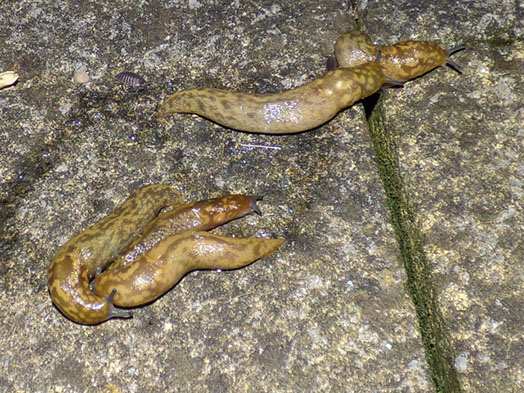
To find out how to identify the baddies click here
Slugs and snails belong to the mollusc family, which includes many sea creatures such as octopus, squid and mussels. There are also varieties of slugs that live in the sea. One grows to 27 cm in length! Image slugs that size on your plot! Sea slugs are incredibly colourful click here to see some photographs. Those of you with garden ponds will also be familiar with the various types of pond snails. You may even have bought snails to eat the algae growing in your fish tank. Within the mollusc family slugs and snails belong to a sub group called gastropod, which also includes many water living cousins. In fact it is the largest sub group in the mollusc family. Gastropod literally means “stomach foot”. The creatures get this name due to the way they move.
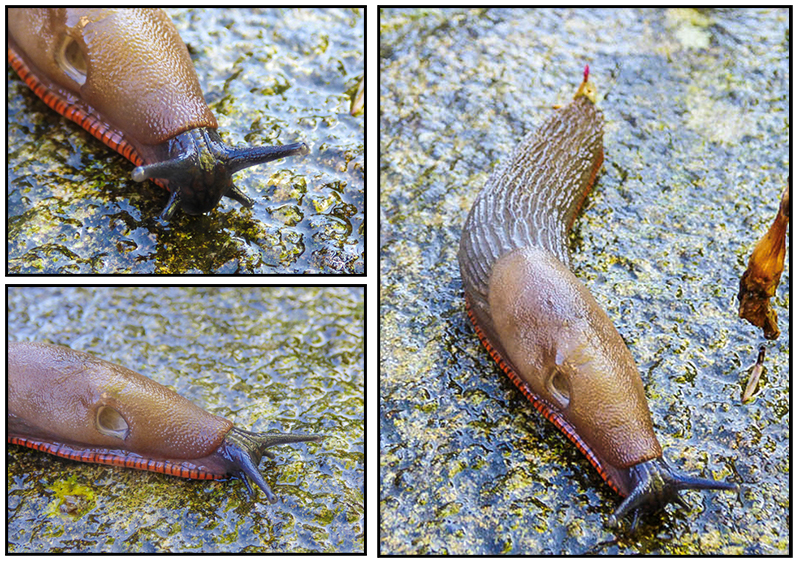
Slugs and snails produce a carpet of slime along which they pull themselves by making rippling movements using muscles on the underside of the body. Their mouth is also situated on the underside of the body and as the slug or snail moves it can feed by rasping vegetation in a way similar to using a nail file or a rasp file used in woodwork. If you pop a slug or snail into a glass jar you can watch how it moves up the side of the glass.
Slugs are often described as snails without shells, which is almost true, however most slugs do have a tiny remnant of a shell but in many varieties this is hidden within the mantle. The mantle is the area behind the head of the slug). The mantle also encloses the slug’s lung and it breathes though a low hole in the side of its body.

Due to the lack of a shell the slug has a much wider habitat than a snail, which needs a source of calcium in order to grow and keep its shell in good condition.
If you look very closely at a slug you may be able to see many tiny mites running all over the slugs body and even in and out of its breathing hole, however this does not seem to trouble the slug and it is likely that the mites feed on debris and mucus on the slugs body.
Slugs have two pairs of tentacles, one pair being shorter than the others. The lower shorter pair of tentacles enables the slug to smell, taste their food and feel their way around. They can detect food several feet away. The slug’s eyes are located at the end of the longer pair of tentacles and it is possible that they can also smell using these tentacles. Their eyes are very simple and only really detect light and dark areas. When watching slugs you will notice that these tentacles move around gathering information about the surroundings.
If a slug is surprised, for instance by suddenly touching something it will withdraw its tentacles into its body to protect them. Although the slug can grow new tentacles if they are damaged this can take quite a long time. Slugs can also contract their whole body into a blob if they are touched or alarmed.
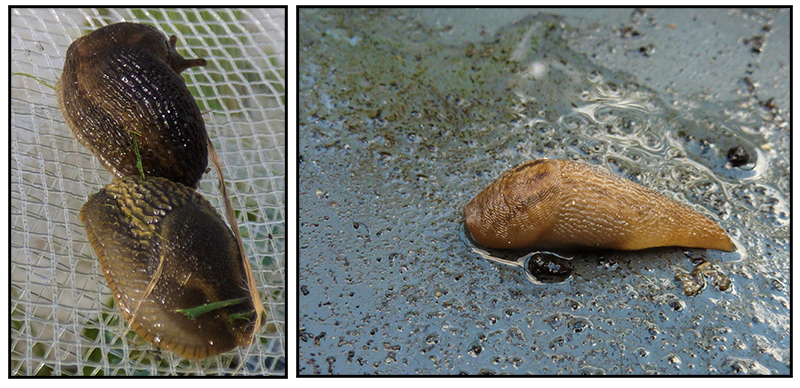
Unfortunately for us the weather conditions in the UK are ideal for slugs and snails, and milder winters make it an even better place for these creatures to set up home. In very dry or cold weather slugs head deep into the soil for protection. Some slugs spend most of their time underground feeding on roots and tubers. Slugs also favour oil-seed rape and the practice of growing this widely across the country is likely to cause an increase in the numbers of slugs.
A slug has no internal skeleton and its soft body has no protection from losing water so it needs to live in damp places. It usually only ventures out at night or on wet days, although it doesn’t like the feel of rain falling on its body.
Slugs prefer to live in heavy, wet soil, cracks in soil providing ideal hiding places during the day. The clay soil at Green Lane provides an ideal environment for them.
They especially like warm wet conditions in which to lay their eggs. Slugs and snails are hermaphrodite meaning that each animal has both male and female parts and therefore every one of them is able to lay eggs. Usually, however, they do mate before each of the pair produce eggs. These look like small round pearls or tapioca and are laid in batches of 10 – 50. (I’ll include a photo here when I find some eggs).
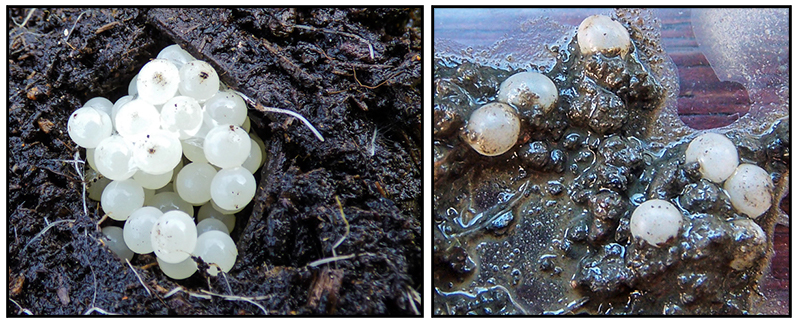
In a year a slug can lay 6 batches of eggs although about a third of slugs will die after egg laying. In a lifespan of about two years a lucky slug has the potential of producing over 500 eggs. It can be fascinating to watch the young slugs or snails develop, as the eggs are transparent. The length of time that it takes for the eggs to develop varies according to weather conditions. In cold weather the eggs can lay in the soil for many months whereas in warm weather it can take as little as 10 days for them to develop. The young will be capable of producing eggs in less than a year. Although many eggs and young will fail to reach maturity that is still a lot of slugs!
Hedgehogs, slow-worms, frogs, toads, ground beetles and ducks prey upon slugs. Encouraging these creatures into your garden or plot can help control the slug population.
Rotavating the soil in spring can also help cut down numbers of slugs as not only does this kill the slugs but many slugs and eggs are brought to the surface where birds will pick them off for lunch.
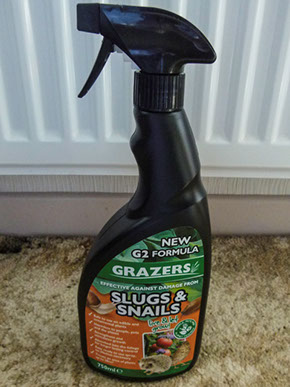 Many influential gardeners advocate that you go out at night with a torch and hand pick which may be a possibility in your own garden but would be a mammoth task on our plot and I think I am too squeamish to deal with them after having caught them.
Many influential gardeners advocate that you go out at night with a torch and hand pick which may be a possibility in your own garden but would be a mammoth task on our plot and I think I am too squeamish to deal with them after having caught them.
If you need to resort to the use of slug pellets then these should be used very sparingly and be careful to choose a less harmful type of chemical. Always take care when using slug pellets where other animals are likely to be attracted to them. There have been several cases of poisoning in dogs caused by them ingesting metaldehyde pellets. If they ingest enough of this poison they become overexcited, begin to have fits and eventually fall into a coma and die.
There seems to be as many ideas for controlling slugs, as there are gardeners so if you want to get more ideas try these sites.
The Royal Horticultural Society
We have found a ring of smeared vaseline to be effective in protecting plants in tubs but the tubs need to be placed in such a position that the creatures can’t gain access by avoiding the protective ring.
We use a product by Grazers to protect our hostas which seems to be effective but it need applying regularly.
Our Plot at Green Lane Allotments Blog | A Gardener's Weather Diary | School Vegetable Patch Website
© Our Plot on Green Lane Allotments - Please email me if you wish to use any of this site's content